The Herne Bay Convalescent Home was the first of ten homes run by the Railway Industry for railwayworkers.
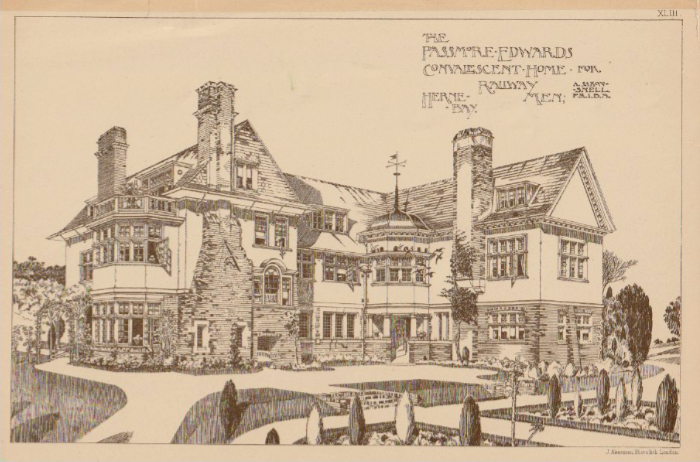
History
The Herne Bay Convalescent Home was the first of ten homes to be opened by the Railway Industry for railway workers; the idea of John Edwards Nichols, cashier of the London, Chatham & Dover Railway, who saw the need for a home where railwayworkers could go to rest and recover from sickness and ill-health.
Nichols was already involved with the friendly Societies and had played a part in setting up the Friendly Societies’ Home at Herne Bay and, as a member of the Manchester Unity of Oddfellows, had become acquainted with Passmore Edwards.
The first Convalescent Home for Railway men, at Herne bay, Kent Nichols was aware of an area of land, about 3 acres, adjacent to the Passmore Edwards Friendly Society Home then under construction at Herne Bay and during a meeting with him, in early 1898, asked him his intentions. His reply filled him with dismay. Passmore Edwards said that he had intended to build a Nurses Home on the site but seeing the disappointment this produced Passmore Edwards asked the reason for his interest. Nichols took this opportunity to inform him, with great enthusiasm, of the pressing need to provide convalescent care for men engaged in vital public services, such as railway workers. However, Passmore Edwards remained unmoved.
Later that year Nichols again raised the issue of the need for a Convalescent Home for the railway workers and the vacant land at Herne Bay, Passmore Edwards became rather iritated and after repeating his intention to build a Nurses’ Home concluded the conversation by saying “the case, Mr Nichols, is now closed”.
Whilst many would have accepted this response as the end to the matter, Nichols was not so easily dissuaded and on the third attempt Passmore Edwards agreed no only to giving the land but an additional £6000 towards the cost of the building.
Central to Passmore Edwards offer was that “nine men of good standing with their respective railway companies and of good repute among theire fellow workers; length of service not less than twenty years, rank not to count, be assembled and informed of the scheme”. Passmore was to meet with this group as soon as possible so that a Trust Deed could be drawn up, but he stressed the need for speedy action. It was his intention that, if such a Home was to be built then he intended to lay the foundation stome on the same day as the one chosen to open the Friendly Society Home.
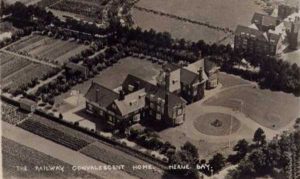
an airial view 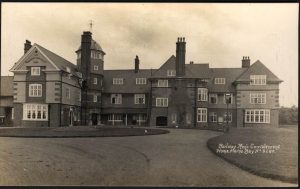
The Home 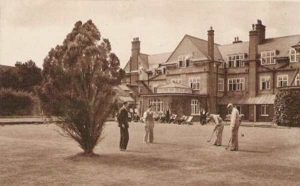
The putting green
Nichols chose to enlist the help of the Press and wrote to the Railway Herald, this letter appearing in 7 January 1899. Within a week or so Nichols had sufficient replies to arrange a meeting on 19 January 1899 at which the selected representatives, including W J Day, an engine driver from the Great Northern Railway and T Bartle a Checker in the Goods Dept of the L & NWR, were present.
Mr W T Culver, Stationmaster at Canon Street was elected to the Chair and the result of this historic meeting was the unanimous acceptance of the motion that ” We the railwaymen, representing the men employed on the nine principal railways having termini in London, do hereby signify our willingness to become trustees of the Passmore Edwards proposed Home , subject to his approval.
The trustees, including Nichols, were in a position to sign the Trust Deed by April 1899 and they began the process of setting up the organisation which was going to be essential to attract the regular flow of subscriptions needed to support the Home once established.
At this time Nichols was elected to take over as Chairman.
The business of constructing and opening the Home was also of some urgency and Sexton Snell was appointed architect.. The foundation stone was laid on 12 June 1899 by the Rt Hon Earl of Amherst.
On 31 August 1899 the trustees met to consider tenders for the new building and decided to accept a tender from H Wall & Co, of Kentish Town, of £8,367 for a Home accommodating fifty beds. At the same meeting it was agreed to accept as an additional trustee a representative from the Great Central Railaway, originally not in attendance at the original meeting.
By the end of the summer of 1899 the project was in full process. The full constitution of the Board had been completed and the building was beginning to take shape.
Many of the standards of policy and proceedure had been agreed upon.
The year of 1900, however, was the most critical in the history of the Railway Convalescent Homes. Whilst work on the building was so advanced by March that details of the opening cermony were being discussed, growing financial problems were also needing to be addressed.
Nichols, as both Chairman of the Board and Passmore Edwards’ accredited representative, had been given a free hand in relation to the building scheme. He had propose, and his proposal readily accepted by the trustees, that the size of the building should be enlarged so as to accommpodate 100 patients rather than the original 50. The total cost, including all of the equipment and furnishings was to be £5000 more than the £6000 promised by Passmore Edwards. An appeal went out for further donations but the response was poor. Nichols approached Passmore Edwards again to ask him to extend his generosity but his response was short. ” Provision for 100 beds was not thought of or mentioned that I know of when it was decided to provide the Home. Please not calculate on more than my promised £6000 from me. Yours faithfully, J Passmore Edwards.”.
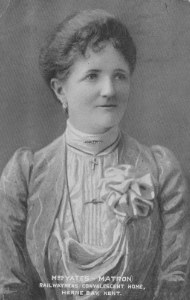
It was decided that a loan should be raised through the Railway Superannuation fund but an application to the Railway Guards Friendly Society for £2000 was not successful. Matters came to a head when the builders obtained a writ for pocession of the unfinished building pending settlement of their account. The only response from Passmore Edwards, following an appeal from the Chairman of the Great Eastern Company, was to offer to take the building over for a nurses’ home as originally planned.
Finally a request was made to the trustees bankers, Glyn, Mills, Currie & Co for an overdraft of up to £2000 with the Deeds of the property as security and a formal guarantee on behalf or each of the trustees. This was accepted by all but one of the trustees and bulding work was completed. Passmore Edwards followed this with a further £1000 principally for a “building fund” but agreed that this could be used for the much needed furnishings.
With the beginning of 1901 came the completion of the building and the installation of furnishings and equipment. A caretaker was appointed who also acted as gardener and the remaining staff, including Matron- Mrs Yates, who took up her post on 29 May.
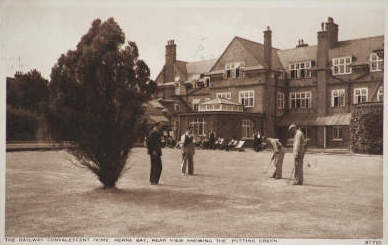
the putting green 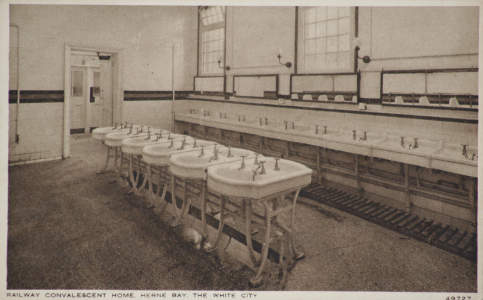
White City
The Rt Hon Sir Henry Campbell Bannerman, at the invitation of Passmore Edwards, had agreed to open the Home on 8 June 1901. The railway companies cooperated by providing free travel to the event for trustees, committee-men and guests and the Home was opened in perfectly fine weather. Numerous tributes were paid to the trustees were given and promises made for future support. The sincerity of these promises was reflected in the accounts for 1901 which showed a total of £262 in donations from officials of the railway companies.
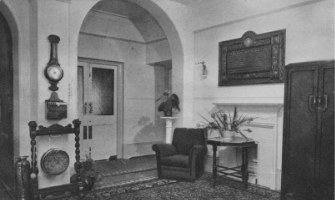
The Entrance 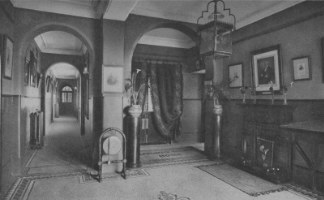
Reception
During the first six months 131 workers had taken advantage of the permitted fortnights rest at the Home, free of charge, under the direction of Mrs Yates. In the first full year, 1902, the number was 465 and in 1903, 725. Passmore Edwards made a surprise appearance at the 28 July,1903 meeting of the trustees, many of whom had not seen their benefactor. By 1904 subscriptions, at 1/2d or 1d per week, amounted to almost £3000 and the number of “patients” 1030; all receiving at least two weeks free care.At this time the final repayment to the bank was made and the Home ended the year significantly in credit.
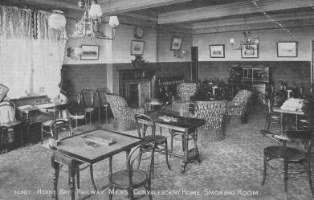
smoking room 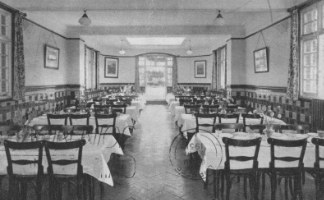
dining room
By 1906 an additional wing to provide a further 50 beds had been added, opened on 24 July, by Princess Louise. Even this substantial enlargement did not meet the growing demands for admission and the realisation that the lengthy journey to the Home from the north and West of the Country was not beneficial to the patients health and recouparation. A search for further premises began, together with the setting up of a “New Home” Fund. As at the Pegwell Bay Home there were photographs taken of each turnaround of residents. I have often been contacted by descedents of one of these residents looking for further information about their ancestor. I am unable to give any details of anyone who stayed at any of the homes but always appreciate a copy of the photograph for my records.

In 1910 the Trustees agreed to purchase Leasowe Castle on the Wirral at a cost, including furniture and abouit 30 acres, of £12,000.
Leasowe opened in 1911 to be followed, in 1915, the Ilkely Home and in 1919 a home in the South West, Bridge House at Dawlish, was opened to accommodate another 84 patients. Before the Great War, Mrs Calver, the wife of the Secretary of the Convalescent Homes had been given the Old Wool Hall at Lavenham, by Princess Louise, and this had been converted and opened as The Railway Women’s Convalescent Home. In 1921 Mrs Calvert offered this home to the Railwaymen’s Convalescent Homes and the organisation was renamed the Railway Convalescent Homes.
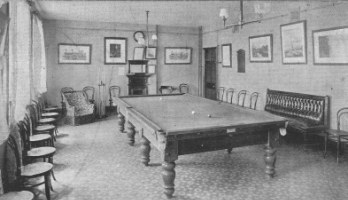
Billiard Room 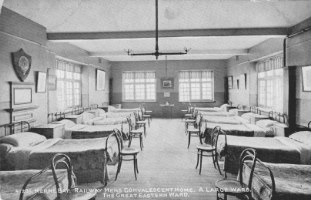
The Great Eastern Ward
At the outbreak of WW1 the homes were made available to the War Office and Herne Bay became a military hospital. A further Home was added to the list, in 1918, at Dawlish.
In the years between the wars the number of patients, and contributors, rose steadily. In 1922 the railway management agreed to offer free travel to the homes whereas previously patients had to fund their own travel arrangements, restricting those poorer workers from travelling too far. This concession, together with an agreement with the railway companies to deduct contributions direct from wages, ensuring a more reliable income, encouraged the purchase of a further home, in 1924, at Ascog manor, near Rothesay, followed by Trenython, near Par, Cornwall, in 1925 and, in 1927, a Home solely for women at Shottendame, Margate.
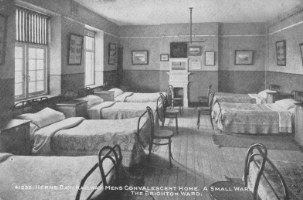
The Brighton Ward 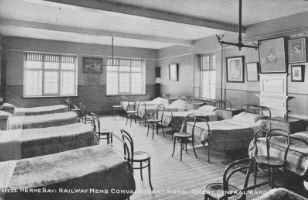
The Great Central Ward
At the outbreak of WW2 Herne Bay again became a hospital and remained as such until after the war, reopening as a Convalescent Home on 1 January 1946. Further purchases were made at Buxton (presented by the American Federation of Labor and the Congress of Industrial Organisations and opened on 20 September by Paul Felix Warburg, on behalf of the American Ambassador)-an administrative building at Baker St London and finally The Old Abbey, Llandudno (presented by the LMS Hospital Fund and opened, for employed women only, on 9 May 1950 by the Rt Hon Lord Latham.
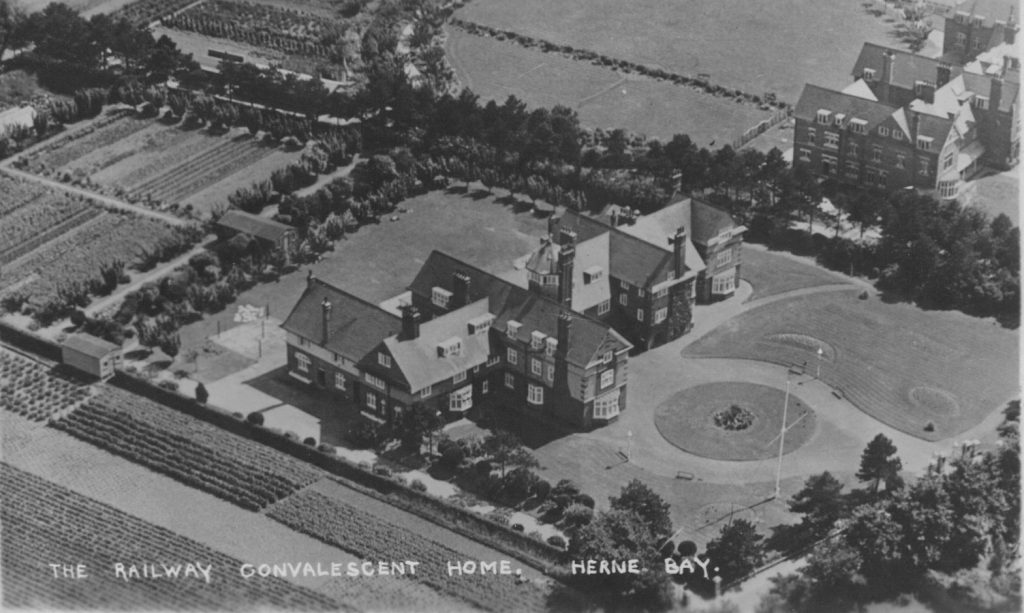
An airial view of the home 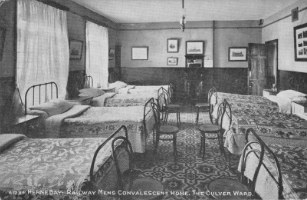
The Culver Ward
The Golden Jubilee was celebrated at Herne Bay, in 1951, by which time 41,520 railwaymen had made use of its facilities. Further extensions had been added in 1914 and in 1928, to accommodate 115 beds, and by 1947 admissions reached 7,000 per year. A ground floor ward was provided for those that had difficulty with the stairs to the two upper floors.There were extensive garden, bowling green and well kept lawns, whilst, being just a quarter of a mile from the sea, the prevailing sea breezes were welcomed by those recovering from their debility.
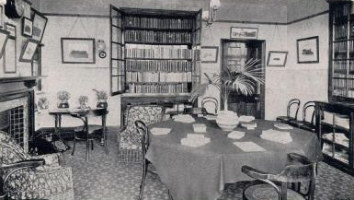
The library 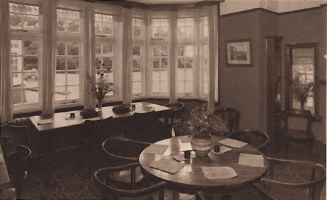
THe writing room
The post war years saw economic stagnation; the nationalisation of the railways reduced the number of employees and the introduction of the National Health Service brought better healthcare and reduced the need for Convalescent Homes. A programme of reduction in the number of Homes but modernisation of those that remained was introduced. In the early 1970’s Herne Bay closed for major refurbishment, including the provision of a lift for disabled patients but the Home was never reopened. Faced with continual financial problems the Home was leased as a residential home for the elderly, Heronswood, which opened in 1980. After 15 years the Home went into receivership and again closed.
Reopening as Elliott House, after a one million pound refurbishment, the building continues to provide care for the elderly.
The Railway Convalescent Home Charity, now ‘rch’, today operates only the Dawlish Home in Devon but continues to provide convalescent care for those in need.